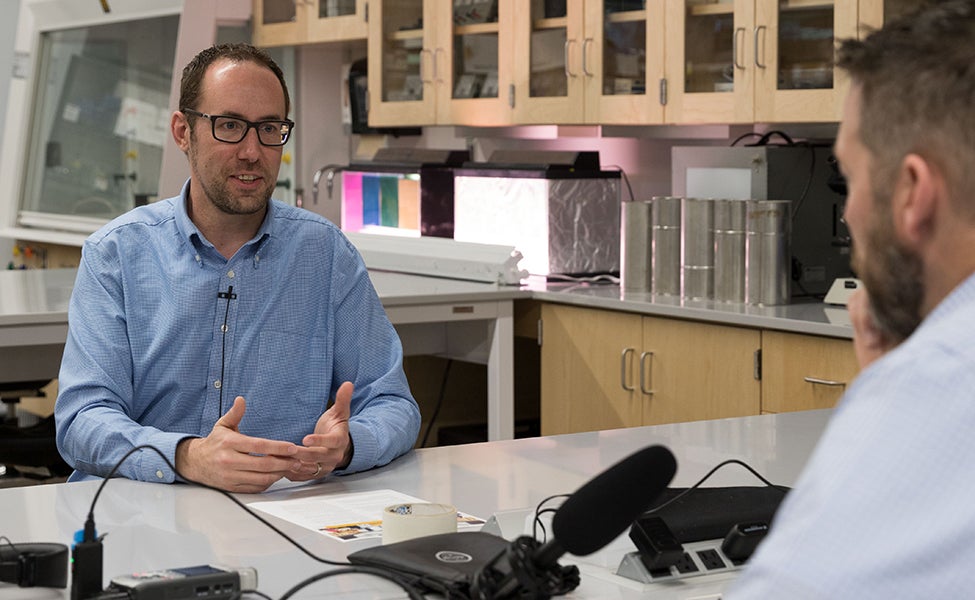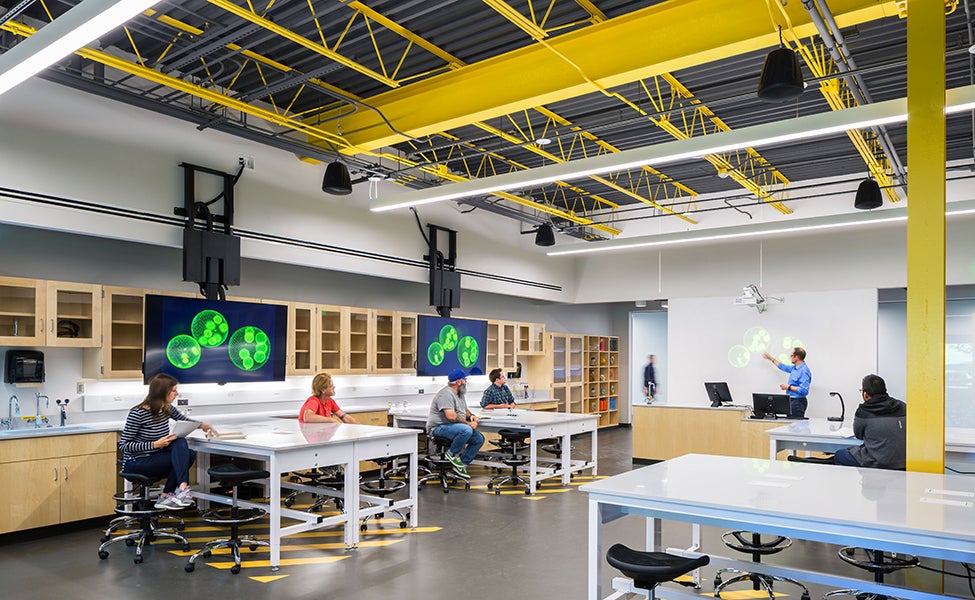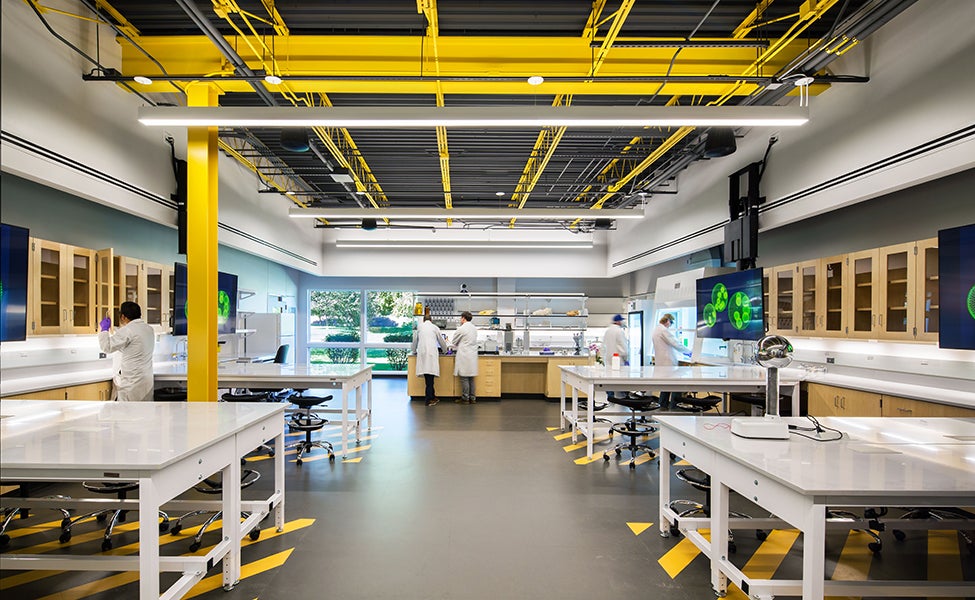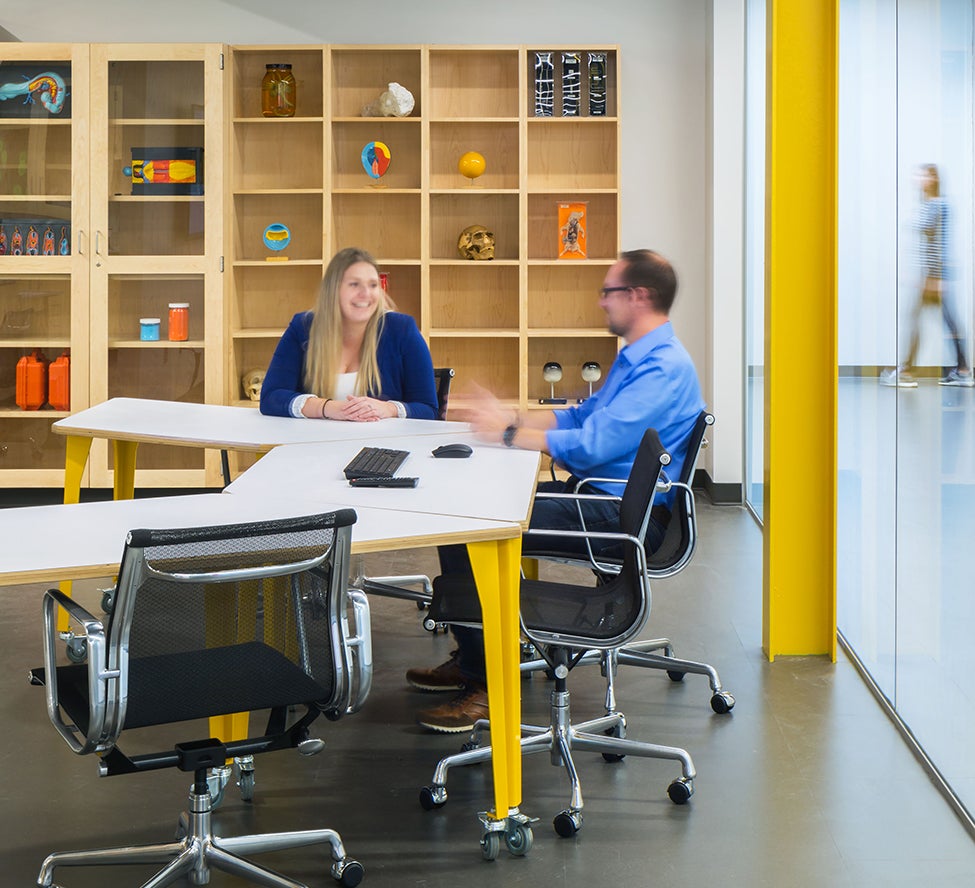
Re-Imagining the Teaching Lab for Inquiry-Based Learning
This spring, HDR’s Mike Hamilton sat down with Professor John Kyndt from Bellevue University, Omaha, Nebraska, for our inaugural Adaptations dialogue. Adaptations is a series of interviews with educators from around the world, representing diverse backgrounds, disciplines and institutions. These interviews examine how educators are adapting to the ever-changing education landscape and how the built environment helps or hinders them in that effort.
Our team was energized by Professor Kyndt’s vision for designing a new type of teaching lab that would meet the changing needs of undergraduate science curricula and of higher education as a whole. Part 1 of this interview focuses on what exactly those changes are, the emerging role of inquiry-based education, and how this all informed a collaborative effort to create a “Science, Research and Demonstration” Lab.

Targeting Affordability, Flexibility & Marketability
Mike: From your perspective, what’s the biggest overall challenge facing higher education today?
John: The first challenge I see is from the student’s perspective: They want affordability. Many of them have racked up a lot of debt, or they know people who have. We have to be conscious of that and try to limit our expenses as much as possible. They also want flexibility. Many of our classes at Bellevue include non-traditional students — many are trying to get a secondary degree while working and so they want classes that they can get online or outside their working hours.
The big challenge for us is to make it affordable, make it flexible, but keep the same quality of education. It’s far too easy to make education more affordable and flexible, but lose quality in the process — you have to keep it rigorous.
Mike: What has changed related to teaching undergraduate science over the last 10 years?
John: Well, from a staffing perspective, I have a Ph.D. in Biochemistry, but today I teach things like nutrition and sustainability. I'm broadening what I teach. I think that's something you see across the board — professors have to be more flexible in what they teach. It helps to spread out the use of the professors. While this isn’t necessarily true at all universities, it’s especially true for the universities that are trying to go in new directions or new areas of study. They have to be open to more unconventional ways of doing things.

Mike: Has the curriculum changed at all?
John: Yes, it has. When we build a new curriculum now, we have to take it through a committee that does market analysis. This is basically to make sure that whenever we build out a new class or a new program that there's a market for it. We ask ourselves “Is this program going to be of interest to the marketplace? Is it going to attract students? Are these students going to have jobs when they finish the program?” So that focus has changed quite a bit from what I've seen in the past.
On the industry side, people talk about having to retrain students on basic, simple science techniques once they enter the marketplace. Students have taken these courses and labs, but they don’t really know how to work in an independent research environment. So their employers have to retrain them.
"If you can have students do some basic research from the beginning and throughout their undergraduate experience, hopefully they're better prepared to step into industry and don’t need to be retaught how to pipette or how to do dilutions. They’ll already have honed that skill in school. Our priority is putting more of those applied skills in the curriculum early on."
Professor John Kyndt, Bellevue University
Balancing Skill Acquisition with Curiosity
Mike: In your TEDxOmaha talk from a few years back, you talked a bit about balancing the need to demonstrate the financial benefit of research while still fostering the innate curiosity that's important to scientific discovery. In a similar vein, how do you foster that curiosity in your classrooms and labs, even as marketability and skill acquisition grows in importance?
John: Even with this pressure to make sure students have appropriate skills, you still want to open their minds to a broader perspective and teach them that this is more than just a trade. So it's finding that balance and bringing in a more inquiry-based, research-based curriculum to build curiosity. We want to be asking students from the very beginning of their education, "Okay, so you observe this thing: How do you think this works? Can we do some research on that? How would you test this? How would you set-up the experiment?"
By building that curiosity at the front end of undergraduate students’ experience, you can then layer on the skills. In this way, skills become the tools that allow students to do what they want to do because of the curiosity that has hopefully been sparked. But that’s the challenge to the professor, the educator: to spark that curiosity and still teach useful tools. That’s one of the reasons we're redoing Bellevue’s curriculum and adding inquiry-based, introductory courses.
How Space Can Inhibit or Enable Inquiry-Based Approaches
Mike: How has the physical environment helped or hindered your ability to introduce these new ideas into the curriculum and how has this impacted student learning?
John: In order to do inquiry-based work, you have to have the space, tools and resources available to do the research. When I first came here to Bellevue, we certainly didn't have that. We weren’t at all set up to do any type of research. It was traditional classrooms or lab rooms, without much equipment or much space to do the type of work we need to.
But the renovation made a big difference. Now we have spaces that actually feel like research labs. This space communicates the idea that it’s okay not to be scared of science or research. It’s the whole “science on display” idea — showing that we're doing stuff that's not scary, that you can join us in research as well. We have the equipment and space available to do traditional teaching or to set up as a research lab depending on our need.

Mike: Tell us about your vision for what we called the “Science, Research & Demonstration” or SRD lab, which is where we’re sitting right now.
John: It’s really about taking the room and making it open and multi-purpose. You have a demonstration area in the front of the room where people can see what you’re doing. Glass walls look into a collaborative space. We use that space to allow students from both within and outside the classroom to collaborate — and also to bring in outside speakers to give small presentations. And you have teaching space that is multi-purpose. It can be used as a lab or a traditional classroom. I actually teach a traditional class in here on Tuesday evenings. But theoretically, the bench in the back allows people to come in and do research there. There might be class going on and students might see them and be intrigued. I’m not opposed to having two things going on at the same time in the classroom, because if you go into a real research environment, that’s what happens too. You’re going to have to do your research in the middle of other activities. So it kind of prepares them for that.

Mike: You helped design the lab — you’re an architect in a way, the true renaissance professor.
John: It’s funny, but my 12-year old son actually helped me come up with some of the ideas for the layout of the room. At some point I asked him, “Okay, how do I set this up because I want these three things happening … teaching, research and collaboration.” And his idea was “Well, why don’t you put the teacher in the middle?” And I thought “Well, that’s a great idea. We don’t always need to be up front. What if we start with the instructor in the middle and design the other components around that.”
This interview has been edited and condensed for clarity.

